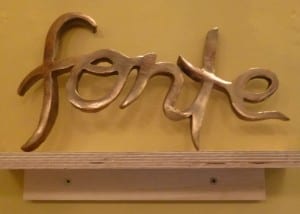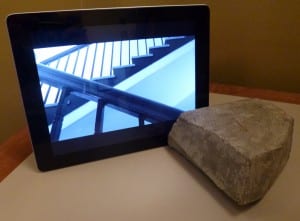One Day in the City Festival
By ucwchrc, on 12 June 2014
One Day in the City Festival at UCL
 One Day in the City Festival taking place on Friday 13th June brings together a celebration of literature, art, music and culture in London. The framework is broad. Nick Shepley, the founder and organiser of the festival, and Teaching Fellow in English Literature at UCL, acknowledges this and says he has not tried to narrow it down to specific themes: “It is about opening out and trying to bring people to something that is a simple celebration of the city, its literature and art, and its cultural richness.” These are areas people work on everyday across various departments at UCL with their own audiences. Nick wants to harness this, and “break down the potential separation of audiences with the One Day festival, encouraging a wider demographic to come along.”
One Day in the City Festival taking place on Friday 13th June brings together a celebration of literature, art, music and culture in London. The framework is broad. Nick Shepley, the founder and organiser of the festival, and Teaching Fellow in English Literature at UCL, acknowledges this and says he has not tried to narrow it down to specific themes: “It is about opening out and trying to bring people to something that is a simple celebration of the city, its literature and art, and its cultural richness.” These are areas people work on everyday across various departments at UCL with their own audiences. Nick wants to harness this, and “break down the potential separation of audiences with the One Day festival, encouraging a wider demographic to come along.”
The festival’s centre will be in the UCL South Cloisters, decorated with a fun and artistic skyline created through lighting and architectural constructions. There will also be a multitude of balloons lining the Cloisters and leading the way to various events. These events will include a debate about taboo language with Inda Knight (journalist and author), Will Self (novelist) and Tim Clare (poet), a Caribbean carnival and seminars on topics related to creativity in London. In the UCL Art Museum there will be a talk by one of the Slade students, Helena Hunter, a poetry workshop and live performances as well as Slade students distributing prints of their work. For a full list, see the One Day website here.
The UCL Art Museum is located in the South Cloisters, so it will be at the hub of the festival’s activities. The remit of ‘One Day’ also links the artwork in the current exhibition at UCL Art Museum to the festival. This exhibition, called ‘Second Person Looking Out’, is the result of this year’s annual UCL Art Museum and Slade collaboration. It features an eclectic range of artwork from time-based media pieces to bronze sculpture and slate engravings. Have a look at my previous blog posts, reviewing the exhibition and talking to Ling the co-Curator, to find out more.
Artworks in the Art Museum’s current exhibition are being reproduced in different ways over the course of the festival in various spaces across UCL. There will be performative art events and spontaneous or unannounced piece of drama. Slade student Maxima Smith made a bronze sculpture for the exhibition. On the day of the festival, instead of using bronze she has created much bigger letters or parts of letters up to 7 feet tall that will form an interactive installation in the South Cloisters. This is just one example of how words and images are intertwined, not only in the Art Museum exhibition but through the One Day Festival as a whole. Nick commented that “one of the Festival’s aims is to move away from ‘word as text’, so there is a lot of spoken word and performance occurring”.
Olga Koroleva, MA Slade Student in Fine Art, explores the interaction of words and images in her time-based media installation at the UCL Art Museum’s exhibition. This video is composed of black and white footage of empty staircases around UCL, predicting or encouraging action, movement and sound by pointing to the noticeable – and unusual – absence of people and bodies moving in these functional spaces. Olga told me that “the video is about a futility of action and balancing something that has a definite purpose with how it has been abstracted in a way that doesn’t make sense any more”. She came up with this idea after being inspired by a Piranesi print, entitled ‘Minerva Medica’, that she found in the UCL Art Museum Collection during her research visits. It suggests a lot of ‘noise’ from the waterfall, people talking and ruinous decay depicted within it, as well as featuring a functionless staircase itself.
Olga’s exploration into text and sound will be extended through her live performance as part of the One Day Festival. Along the staricase leading to the UCL main library a group of eight performers will read out sections of a narrative, which will make up a collective experience of how we use mundane and transitional spaces, particularly staircases. She has recently noticed that her writing and performances are structured largely like theatre scripts, in which a sense of time is inbuilt. The works’ preoccupation with time does, of course, link well to the framework of the festival. Overall, Olga hopes that her live performance will allow “visitors to reflect on the space – a generic space. The moment of recognition and seeing things anew are important. It’s about altering the way we perceive a space without altering the space itself, so the experience is channelled through something that is ephemeral.”
When talking with Nick about further ways in which the UCL Art Museum and the One Day Festival are linking up, he emphasised that “it will be fascinating to see how there is an exhibition in one space that stays the same for the course of that show. Then there is one day when there are lots of Pop-Ups that occur in loud, vibrant, slightly-attention grabbing ways. I love this balancing of movement and stasis: We witness all these explosions, but hopefully people will tie them back to the quieter, more contained works and re-experience them again after that – just as we do in life when we go about our normal day to day and then have moments that draw us out of our routines, before we re-submerge. Paradoxically it creates a value in the day-to-day, rather than in the ‘explosions’”.
 Nick admits there are different responses to the notion that One Day in the City Festival is a free event. Keeping it free encapsulates the ethos of the whole project, as he is keen to draw anyone from anywhere who has an interest in what is going on and hope that they come to their one specific event, but through that they are pushed through the emersion of different performances, theatre, and dance. “It’s very much about bringing people to the environment and then letting them find their own avenues. It’s very egalitarian in that way. This is reflected in the posters because students and well-known poets have their names next to each other, there is no hierarchy. We don’t have to sell books or tickets, which a lot of literary festivals are driven by, so we have the opportunity to experiment more and combine different audiences and demographics”.
Nick admits there are different responses to the notion that One Day in the City Festival is a free event. Keeping it free encapsulates the ethos of the whole project, as he is keen to draw anyone from anywhere who has an interest in what is going on and hope that they come to their one specific event, but through that they are pushed through the emersion of different performances, theatre, and dance. “It’s very much about bringing people to the environment and then letting them find their own avenues. It’s very egalitarian in that way. This is reflected in the posters because students and well-known poets have their names next to each other, there is no hierarchy. We don’t have to sell books or tickets, which a lot of literary festivals are driven by, so we have the opportunity to experiment more and combine different audiences and demographics”.
Nick’s second book is on one day novels particularly in the early 20th century where he states “there was a desire to give a framework that then could be exploded to explore the realities of modernity and living in cities, and how we represent the flux and indeterminacy of everyday living in something as static as text and word. So the 24 hours became a way of delimiting and holding some form of plot structure, when a day might not be a particularly important day, but it can be relayed and thus we get a sense of experience”. With the One Day in the City Festival Nick wants to celebrate this complexity, as well as all the different things happening at UCL and in all its museums.
Helen Cobby is a volunteer at UCL Art Museum and is studying an MA in the History of Art at UCL.
2 Responses to “One Day in the City Festival”
- 1
-
2
One Day in the City Festival at UCL | Helen Cobby wrote on 12 June 2014:

[…] This article is published on the UCL Art Museum blog […]
 Close
Close





This sounds a fascinating event, looking forward to it!